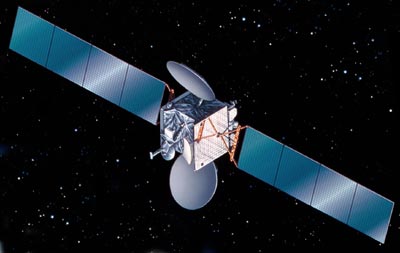Thank you very much for visiting Gunter's Space Page. I hope that this site is useful and informative for you.
If you appreciate the information provided on this site, please consider supporting my work by making a simple and secure donation via PayPal. Please help to run the website and keep everything free of charge. Thank you very much.
Astra 1G, 1H, 2A, 2C

Astra 2A [Boeing BSS]
SES ordered its Hughes 601 satellites, in 1994 for Astra 1G; in 1995 for Astra 1H; and in 1996 for Astra 2A. In August 1999, SES ordered Astra 2C, another Hughes 601HP
The Hughes' 601 satellite was designed for the higher-power missions of the 1990s. The
model was introduced in 1987 to meet anticipated requirements for high-power,
multiple-payload satellites for such uses as direct television broadcasting to small
antennas, mobile communications, and private business networks.
All the satellites operate in Ku-band and use traveling-wave tube amplifiers (TWTAs) for power. The TWTAs provide 100 Watts on Astra 1G and 1H, and 98.5 Watts on Astra 2A.
Astra 1G, 1H, and 2A will have a minimum of 28 active transponders with 32 being available for the first five years.
The satellites enable SES to provide analog and digital television programs together. Most operate at 19.2 degrees East longitude. On Astra 1C, the 18 transmission frequencies can be selected on-orbit from 34 possibilities. On 1G, 1H, and 2A 56 possibilities are available, most in the BSS band. Because each spacecraft will provide an effective isotropic radiated power (EIRP) typically 51 dBW, these satellites deliver video and audio signals strong enough to be received by existing 60-cm dishes.
Astra 1G is the first in the series with the HS 601HP (for high power) configuration. Astra 2A is identical, but is located at SES' second orbital position of 28.2 degrees East. Enhancements over the basic HS 601 design include the use of gallium arsenide solar cells, instead of silicon, to generate 6 kilowatts of payload power for the Astra spacecraft. Another new feature is an advanced antenna design, using two large lightweight Gregorian reflector systems featuring Hughes' contoured-surface technology.
Astra 1G and 1H also have four solar panels per wing, with the high-efficiency gallium arsenide solar cells. Astra 1G and 1H use a more powerful battery with 24 large nickel-hydrogen cells.
On the spacecraft, a flight-proven bipropellant propulsion system with an integral 490-Newton (110-lbf) Marquardt liquid apogee motor and 12 thrusters provides the impulse to achieve and maintain the orbit and attitude necessary for geosynchronous operation.
Astra 2A is using Hughes' xenon ion propulsion system (XIPS) for north/south stationkeeping. This technology provides a significant reduction in launch mass while maintaining the 15-year service life. Astra 2C will also use XIPS.
ASTRA 2C will provide pan-European coverage. The satellite will have the flexibility to operate at SES' primary slot of 19.2 degree East longitude. ASTRA 2C, a body-stabilized spacecraft, will operate with 28 Ku-band transponders.
| Nation: | Luxembourg |
|---|---|
| Type / Application: | Communication (Direct Broadcasting) |
| Operator: | SES |
| Contractors: | Hughes / Boeing |
| Equipment: | 32 Ku-band transponders (all), 2 Ka-band transponders (only #1H) |
| Configuration: | HS-601HP / BSS-601HP |
| Propulsion: | R-4D-11-300, 4 × XIPS-13 ion engines (except #1G) |
| Power: | 2 deployable solar arrays, batteries |
| Lifetime: | 15 years |
| Mass: | 3379 kg (#1G), 3700 kg (#1H), 3626 kg (#2A), 3643 kg (#2C) |
| Orbit: | GEO |
| Satellite | COSPAR | Date | LS | Launch Vehicle | Remarks | |
|---|---|---|---|---|---|---|
| Astra 1G | 1997-076A | 02.12.1997 | Ba LC-81/23 | Proton-K Blok-DM3 | ||
| Astra 1H | 1999-033A | 18.06.1999 | Ba LC-81/23 | Proton-K Blok-DM3 | ||
| Astra 2A | 1998-050A | 30.08.1998 | Ba LC-81/23 | Proton-K Blok-DM3 | ||
| Astra 2C | 2001-025A | 16.06.2001 | Ba LC-81/23 | Proton-K Blok-DM3 |
References:
- Boeing: Astra 1C, 1D, 1E, 1F, 1G
- Boeing: Astra 1H
- Boeing: Astra 2A
- Boeing: Astra 2C
- Astra 1A [AS-4000]
- Astra 1B [AS-5000]
- Astra 1C, 1D [HS-601]
- Astra 1E, 1F [HS-601]
- Astra 1G, 1H, 2A, 2C [BSS-601HP]
- Astra 1K [Spacebus-3000B3S]
- Astra 1KR [A2100AXS]
- Astra 1L [A2100AXS]
- Astra 1M [Eurostar-3000]
- Astra 1N [Eurostar-3000]
- Astra 1P [Spacebus-NEO-200]
- Astra 1Q [Space Inspire]
- Astra 2B [Eurostar-2000+]
- Astra 2D, 3A [BSS-376HP]
- Astra 2E, 2F, 2G [Eurostar-3000]
- Astra 3B [Eurostar-3000]
Astra 4A[Spacebus-4000C3]- Astra 4A [A2100AXS]
- Astra 4B [SSL-1300]
- Astra 5A [Spacebus-3000B2]
- Astra 5B [Eurostar-3000]
